
Manchester is the most populous city in the U.S. state of New Hampshire and in northern New England. At the 2020 census, it had a population of 115,644.

The Shay locomotive is a geared steam locomotive that originated and was primarily used in North America. The locomotives were built to the patents of Ephraim Shay, who has been credited with the popularization of the concept of a geared steam locomotive. Although the design of Ephraim Shay's early locomotives differed from later ones, there is a clear line of development that joins all Shays. Shay locomotives were especially suited to logging, mining and industrial operations and could operate successfully on steep or poor quality track.

The American Locomotive Company was an American manufacturer of locomotives, diesel generators, steel, and tanks that operated from 1901 to 1969. The company was formed by the merger of seven smaller locomotive manufacturers and Schenectady Locomotive Engine Manufactory of Schenectady, New York. A subsidiary, American Locomotive Automobile Company, designed and manufactured automobiles under the Alco brand from 1905 to 1913. ALCO also produced nuclear reactors from 1954 to 1962.

The Chicago, Burlington and Quincy Railroad was a railroad that operated in the Midwestern United States. Commonly referred to as the Burlington Route, the Burlington, or as the Q, it operated extensive trackage in the states of Colorado, Illinois, Iowa, Missouri, Nebraska, Wisconsin, Wyoming, and also in Texas through subsidiaries Colorado and Southern Railway, Fort Worth and Denver Railway, and Burlington-Rock Island Railroad. Its primary connections included Chicago, Minneapolis–Saint Paul, St. Louis, Kansas City, and Denver. Because of this extensive trackage in the midwest and mountain states, the railroad used the advertising slogans "Everywhere West", "Way of the Zephyrs", and "The Way West".
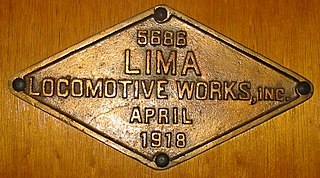
Lima Locomotive Works was an American firm that manufactured railroad locomotives from the 1870s through the 1950s. The company took the most distinctive part of its name from its main shop's location in Lima, Ohio. The shops were located between the Erie Railroad main line, the Baltimore & Ohio's Cincinnati-Toledo main line and the Nickel Plate Road main line and shops.

The Cooke Locomotive and Machine Works, located in Paterson, New Jersey, manufactured steam railroad locomotives from 1852 until it was merged with seven other manufacturers to form American Locomotive Company (ALCO) in 1901.

The Amoskeag Locomotive Works, in Manchester, New Hampshire, built steam locomotives at the dawn of the railroad era in the United States. The locomotive works operated as a division of the Amoskeag Manufacturing Company between 1848 and 1859.
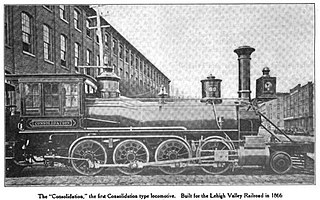
Under the Whyte notation for the classification of steam locomotives, 2-8-0 represents the wheel arrangement of two leading wheels on one axle, usually in a leading truck, eight powered and coupled driving wheels on four axles, and no trailing wheels. In the United States and elsewhere, this wheel arrangement is commonly known as a Consolidation, after the Lehigh and Mahanoy Railroad’s Consolidation, the name of the first 2-8-0.
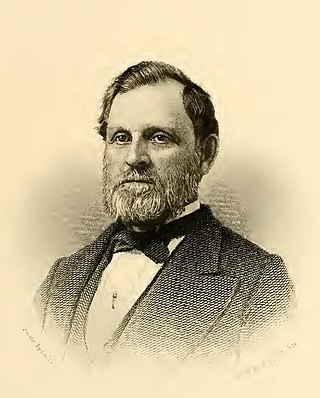
Aretas Blood was an American businessman from Vermont. He played an important role in the manufacture of early American railroad steam locomotives.
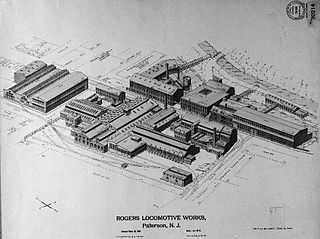
Rogers Locomotive and Machine Works was a 19th-century manufacturer of railroad steam locomotives based in Paterson, in Passaic County, New Jersey, in the United States. It built more than six thousand steam locomotives for railroads around the world. Most 19th-century U.S. railroads owned at least one Rogers-built locomotive. The company's most famous product was a locomotive named The General, built in December 1855, which was one of the principals of the Great Locomotive Chase of the American Civil War.

The St. Louis–San Francisco Railway, commonly known as the "Frisco", was a railroad that operated in the Midwest and South Central United States from 1876 to April 17, 1980. At the end of 1970, it operated 4,547 miles (7,318 km) of road on 6,574 miles (10,580 km) of track, not including subsidiaries Quanah, Acme and Pacific Railway and the Alabama, Tennessee and Northern Railroad; that year, it reported 12,795 million ton-miles of revenue freight and no passengers. It was purchased and absorbed into the Burlington Northern Railroad in 1980. Despite its name, it never came close to San Francisco.
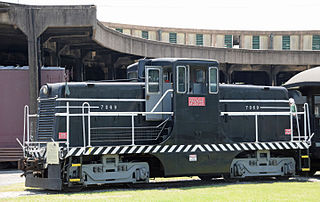
The GE 44-ton switcher is a four-axle diesel-electric locomotive built by General Electric between 1940 and 1956. It was designed for industrial and light switching duties, often replacing steam locomotives that had previously been assigned these chores.
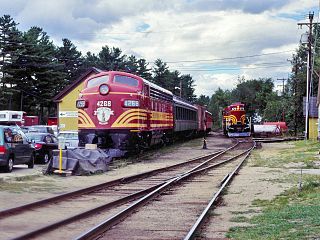
The Conway Scenic Railroad is a heritage railroad in North Conway, New Hampshire, owned by Profile Mountain Holdings Corp. The railroad operates over two historic railway routes: a line from North Conway to Conway that was formerly part of the Conway Branch of the Boston and Maine Railroad, and a line from North Conway through Crawford Notch to Fabyan that was once part of the Mountain Division of the Maine Central Railroad. The Conway line is owned by Conway Scenic, and the Mountain Division is owned by the State of New Hampshire.

Richmond Locomotive Works was a steam locomotive manufacturing firm located in Richmond, Virginia.

The Amoskeag Manufacturing Company was a textile manufacturer which founded Manchester, New Hampshire, United States. From modest beginnings it grew throughout the 19th century into the largest cotton textile plant in the world. At its peak, Amoskeag had 17,000 employees and around 30 buildings.

New York Central 3001 is a 4-8-2 "Mohawk" (Mountain)-type steam locomotive built in 1940 by the American Locomotive Company (ALCO) for the New York Central Railroad. Normally known as "Mountain" types, New York Central 4-8-2 steam locomotives were dubbed "Mohawk" types after the Mohawk River, which the New York Central followed. Built for dual service work, the 3001 was used heavily for freight and passenger trains until being retired in 1957. The locomotive is currently on static display at the National New York Central Railroad Museum in Elkhart, Indiana. It is the largest New York Central steam locomotive still in existence and is one of two surviving New York Central Mohawks; the other, No. 2933, which was currently on display at the National Museum of Transportation in St. Louis, Missouri.

Maine Central 470 is a 4-6-2 "Pacific" type steam locomotive built by the American Locomotive Company (ALCO) in May 1924 for the Maine Central Railroad (MEC). The locomotive is currently owned by the New England Steam Corporation. It is currently located at Washington Junction in Hancock, Maine where it is undergoing restoration to operating condition.

Norfolk and Western 433 is a preserved class M 4-8-0 "Mastodon" type steam locomotive built by the American Locomotive Company's Richmond Locomotive Works in January 1907 for the Norfolk and Western Railway. It was one of 125 M Class engines in operation on the N&W for around 50 years. After surviving an accident in 1951, the 433 was rebuilt and worked in Bristol, Virginia for a time where she was also assigned as a back up locomotive for the Abingdon Branch. This "Mollie" also worked as a switcher in Roanoke, Salem, and Radford. The 433 was eventually retired in 1958 and it became one of only two M Class locomotives to survive aside from the "Lost Engines of Roanoke". It was cosmetically restored in 2002 and now resides as a static display along the old Virginia Creeper Trail in Abingdon.

Grand Trunk Western No. 6323 is a preserved class "U-3-b" 4-8-4 "Northern" type steam locomotive built by Alco in 1942. It served the Grand Trunk Western Railroad by pulling various heavy freight and passenger trains across the Lower Peninsula of Michigan and Northern Indiana. It became famous in later years for being the very last active steam locomotive to run on the GTW's trackage while still on the railroad's active list in 1961. After sitting in storage for several years in Detroit, No. 6323 was sold in 1981 to the Illinois Railway Museum, and since then, it has remained on static display in Union, Illinois.

























